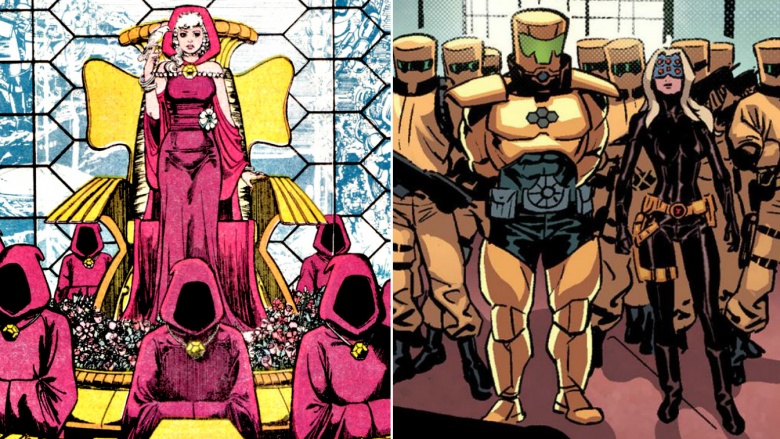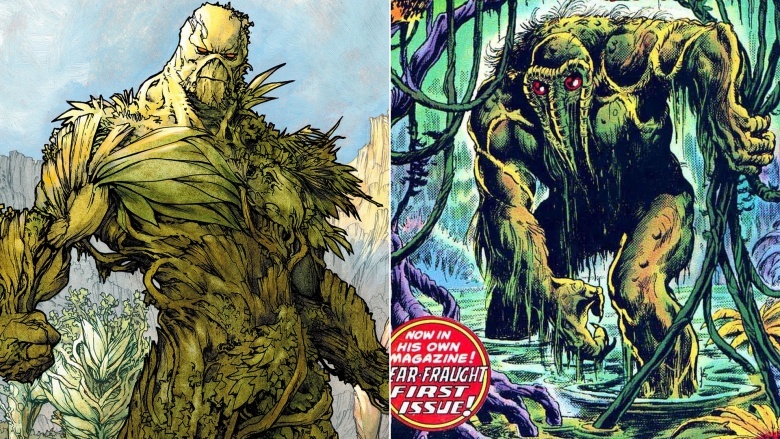Characters DC Stole From Marvel And Gave A New Name
There is no shortage of Marvel characters who seem to have been "inspired" by super-people who first made their debut in the pages of DC Comics. You can read all about some of the more obvious DC copies that showed up at Marvel right here. But what about characters and concepts that went the other way? Here are a few DC Comics heroes and villains that seem a little familiar...because they were Marvel characters first.
Aquaman (1941) vs. Sub-Mariner (1939)
Back in 1939, the company then-known as Timely Comics published Marvel Comics #1. The issue featured a sea-dwelling jerkface named Namor, the Sub-Mariner, who terrorized the surface world because of its inhabitants' abuse of the oceans. He regularly fought the original Human Torch, but Namor would soon fight for humanity when he teamed up with the Torch and Captain America in the fight against the Nazis in World War II. Two years later, National Comics, which would later become DC, published More Fun Comics #73, which provided the first appearance of Aquaman...a guy whose scientist dad gave the ability to breathe underwater and talk to fish. Many years later, Aquaman would gain a surly disposition towards the surface world while ruling an Atlantean kingdom...two defining characteristics that Namor had first.
Guardian (1942) vs. Captain America (1941)
Soon after Timely Comics published the first issue of Captain America back in 1941, the character it was named after became a smash hit. The shield-wielding, Nazi-punching super-patriot proved so popular, in fact, that his creators, Joe Simon and Jack Kirby, were annoyed at not earning as much as they were promised. They skipped out on Timely and headed over to National Comics, where they created the Guardian in 1942. Instead of a soldier-turned-superhero, the Guardian was a cop-turned-crusader. Though his design was pretty simple compared with Captain America, the two shared more than a few visual similarities, which is most apparent in each of their shields. Guardian has popped up in various different forms throughout DC Comics' history since his creation. But he's never had nearly the same kind of popularity or lasting power as Cap.
New Teen Titans (1980) vs. Uncanny X-Men (1975)
Many comic fans have pointed out the similarities between DC Comics' Doom Patrol and Marvel's X-Men, both of which made their comic book debuts in 1963, with Doom Patrol edging out the mutants by three months. But in 1975, Marvel relaunched the X-Men with an almost entirely new lineup of characters like Nightcrawler, Colossus, and Banshee, while bringing one-time Incredible Hulk adversary Wolverine into the mix. It was a smash, and the X-Men went from second-tier superheroes to one of the industry's most popular franchises. In 1980, DC Comics looked to replicate that success. They took one of their old superhero teams—the Teen Titans, which was comprised of sidekicks like Robin, Kid Flash, and Wonder Girl—and, well, basically made them the X-Men. They added new characters like Cyborg, Starfire, and Raven, while reintroducing an older character, Beast Boy, as Changeling. Interesting side note: Beast Boy made his first appearance in—that's right—the Doom Patrol. It all comes full circle, you guys. The two books proved so popular in the 1980s that the teams had a popular and successful crossover in 1982.
Kobra (1976) vs. Hydra (1965)
If you've watched any of the Captain America movies—and if you're reading this, you probably have—you know who Hydra is. Created by Stan Lee and Jack Kirby, they're the green-wearing group of fanatical terrorist bad guys in the Marvel Universe who frequently plague Nick Fury, SHIELD, and the rest of the rest of the superheroes. But did you know that DC Comics has its own slightly crappier version of Hydra? It's true. The Kobra Cult, created by Kirby in 1976, is a snake-obsessed bunch of green-wearing terrorists who follow the orders of a dude who simply goes by the name Kobra. Aside from a few particulars and the kind of serpent creature each group takes its name from, there aren't enough differences between Hydra and Kobra to bother discussing. But Hydra was first.
H.I.V.E. (1980) vs. A.I.M. (1966)
In the Marvel Universe, if you can't afford the services of Hydra, there's a bargain-basement bunch of scientist bad guys running around with yellow buckets on their heads and an even stupider name. Another Lee and Kirby creation from the 1960s, A.I.M. stands for Advanced Idea Mechanics. And while they're not as menacing as Hydra, they did make an appearance in Iron Man 3, shown as being founded by the movie's villain, Aldrich Killian. Naturally, DC Comics needed its own version of A.I.M. The "Hierarchy of International Vengeance and Extermination," or H.I.V.E., was introduced in the second issue of New Teen Titans in 1980. While both teams are alternately interesting and laughable depending on the story, A.I.M. will always have the edge in our hearts, simply because of its leader: MODOK. And what does MODOK stand for? "Mental Organism Designed Only for Killing." That's literally the greatest thing ever, right?
Bumblebee (1976) vs. the Wasp (1963)
In 1961, DC Comics published Showcase #34, which featured a hero named the Atom, a scientist who shrunk down and beat up bad guys with the power of, uh, smallness. In 1962, Marvel published Tales to Astonish #27, which told the story of Ant-Man...a scientist who shrunk down and beat up bad guys with the power of smallness. Plus ants. But then a year later in 1963, Marvel debuted the Wasp, a little lady who helped Ant-Man fight crime with wings and a power to "sting" criminals. It took DC 13 more years to make its own version of the Wasp, and it's a pretty blatant copy in most outward respects. Like the Wasp, Bumblebee is a shrinking lady that stings villains while flying around. Unlike the Wasp, whose name is all-too-appropriate for the sake of this comparison, Bumblebee was actually DC's first female, African-American superhero. Too bad she's never risen above B-level status, known mainly for being a member of various versions of the Teen Titans and the Doom Patrol.
Swamp Thing vs. Man-Thing
There are any number of reasons why so many characters share traits between Marvel and DC, but the most important one might be the incestuous nature of the creative community. Over the years, artists and writers have routinely ditched one publisher for the other, and employees of competing companies are often friends or even roommates—as was the case with DC's Swamp Thing and Marvel's Man-Thing. Man-Thing co-creator Gerry Conway was living with Swamp Thing creator Len Wein when both characters were in development, and they made their first appearances within months of one another—Man-Thing in May of 1971 and Swamp Thing in July. Given all of that, it isn't surprising that both swampy green guys share similar backstories and abilities.
Black Racer (1971) vs. Silver Surfer (1966)
Jack Kirby created one of the most bizarre, yet beloved Marvel characters in 1966: the Silver Surfer. Riding through space on a cosmic surfboard, the Silver Surfer became known as a tragic hero, who sacrificed his life and love to serve the world-eating entity known as Galactus. Eventually, the Surfer rebelled against Galactus and had his own adventures, helping others throughout the cosmos. When Kirby went back to work for DC Comics in the 1970s, he created a whole new mythology as his response to his work on Marvel's Norse God characters, comprised of Thor, Odin, Loki, and the rest. The New Gods, which included Orion, Darkseid, Mister Miracle, and more, included one character who never quite caught on: the Black Racer. He was the New Gods' cosmic God of Death...and he rode around space on skis. To be fair, the living embodiment of super-death riding through space on galactic skis is no less ridiculous than a silver, naked man flying through the stars on a surfboard whose job it is to tell people their planet is about to be eaten. But for whatever reason, the Silver Surfer is cool, and the Black Racer...isn't.








